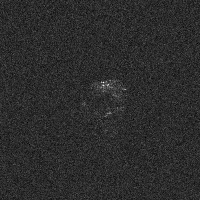(436724) 2011 UW158
 | |
| Discovery[1] | |
|---|---|
| Discovered by | Pan-STARRS at Haleakala (F51) |
| Discovery date | 25 October 2011 |
| Designations | |
| (436724) 2011 UW158 | |
| Apollo NEO, PHA[1] | |
| Orbital characteristics[1] | |
| Epoch 13 January 2016 (JD 2457400.5)[1] | |
| Uncertainty parameter 0 | |
| Observation arc | 1477 days (4.04 yr) |
| Aphelion | 2.2299 AU (333.59 Gm) (Q) |
| Perihelion | 1.0105 AU (151.17 Gm) (q) |
| 1.6202 AU (242.38 Gm) (a) | |
| Eccentricity | 0.37632 (e) |
| 2.06 yr (753.29 d) | |
| 85.320° (M) | |
| 0° 28m 40.44s / day (n) | |
| Inclination | 4.5726° (i) |
| 286.02° (Ω) | |
| 8.7598° (ω) | |
| Earth MOID | 0.00383387 AU (573,539 km) |
| Jupiter MOID | 2.97647 AU (445.274 Gm) |
| TJupiter | 4.242 |
| Physical characteristics | |
| Dimensions | ~300 × 600 m[2] |
| 0.61073 h (36.644 min) | |
| 19.9[1] | |
(436724) 2011 UW158, provisionally known as 2011 UW158, is an Apollo near-Earth asteroid and potentially hazardous object.[1] It was discovered in 2011 from the Pan-STARRS observatory at Haleakala, Hawaii, U.S.A.
The asteroid was listed as level 1 in the Torino Scale on 4 November 2011, 9 days after its discovery,[3] but was removed two weeks later.[4]
On 19 July 2015, it passed about 2.5 million kilometers from Earth,[1] attracting the interest of astronomers. It has an unusually short rotation period of 37 minutes, suggesting it is a large boulder rather than a rubble pile.[5] It also attracted the media and even by firms such as Planetary Resources[6] for its alleged content of precious metals worth as high as 5 trillion U.S. dollars.[7][8][9] Users at Space Exploration StackExchange have denied these estimations as being orders of magnitude too high.[10]
References
- ^ a b c d e f g "JPL Small-Body Database Browser" (Last Updated: 2015-06-04, observation arc 3.74 yr). Jet Propulsion Laboratory. Retrieved 8 April 2016.
- ^ "Solar System Studies at Arecibo Observatory". Arecibo Observatory. Retrieved 2015-07-23.
- ^ "2011 UW158 Impact Risk". Near Earth Object Program. NASA. Archived from the original on November 6, 2011.
{{cite web}}: Unknown parameter|deadurl=ignored (|url-status=suggested) (help) - ^ "NEOs Removed from Impact Risks Tables". Near Earth Object Program. NASA.
- ^ "First detailed images of rare asteroid to pass close by Earth on 19 July". Retrieved 2015-07-23.
- ^ "Mining Firm Aiming For Platinum-Loaded Asteroid". Retrieved 2015-07-23.
- ^ "UW-158: Watch live as asteroid worth £ 3 TRILLION passes close to Earth". Retrieved 2015-07-23.
- ^ "What you can expect to see as a £3 trillion asteroid passes Earth tonight". Retrieved 2015-07-23.
- ^ "$5 Trillion Dollar Asteroid Makes Close Approach to Earth". Retrieved 2015-07-23.
- ^ "How is it known that asteroid 2011 UW158 has so much platinum?". Retrieved 2015-07-23.
External links
